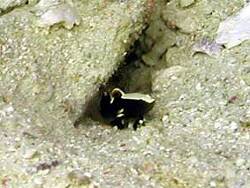Info
Lotilia graciliosa Klausewitz, 1960
Lives in areas with patches of fine carbonate sand on subtidal reef flats and seaward reefs. Uses the burrow of Alpheus rubromaculatus for refuge. Lives in coastal to outer reef habitats in shallow depth to about 10 meters, commonly found on sand and rubble patches close or shaded by low overhanging corals. Lives with the Alpheus rubromaculatus.
Jumping guard
A jumping guard prevents (nocturnal) fish from jumping out.
Wrasses, blennies, hawkfishs and gobies jump out of an unprotected tank in fright if their night rest is disturbed, unfortunately these jumpers are found dried up in the morning on carpets, glass edges or later behind the tank.
https://www.korallenriff.de/en/article/1925_5_Jump_Protection_Solutions_for_Fish_in_the_Aquarium__5_Net_Covers.html
A small night light also helps, as it provides the fish with a means of orientation in the dark!
Lives in areas with patches of fine carbonate sand on subtidal reef flats and seaward reefs. Uses the burrow of Alpheus rubromaculatus for refuge. Lives in coastal to outer reef habitats in shallow depth to about 10 meters, commonly found on sand and rubble patches close or shaded by low overhanging corals. Lives with the Alpheus rubromaculatus.
Jumping guard
A jumping guard prevents (nocturnal) fish from jumping out.
Wrasses, blennies, hawkfishs and gobies jump out of an unprotected tank in fright if their night rest is disturbed, unfortunately these jumpers are found dried up in the morning on carpets, glass edges or later behind the tank.
https://www.korallenriff.de/en/article/1925_5_Jump_Protection_Solutions_for_Fish_in_the_Aquarium__5_Net_Covers.html
A small night light also helps, as it provides the fish with a means of orientation in the dark!







 Rafi Amar, Israel
Rafi Amar, Israel











